Pigeons
| Pigeons | ||||||||||
|---|---|---|---|---|---|---|---|---|---|---|

Pigeons ( Columbidae ) |
||||||||||
| Systematics | ||||||||||
|
||||||||||
| Scientific name of the order | ||||||||||
| Columbiformes | ||||||||||
| Latham , 1790 | ||||||||||
| Scientific name of the family | ||||||||||
| Columbidae | ||||||||||
| Illiger , 1811 |
The pigeons (Columbidae) are a species-rich family of birds . They are the only family of the order of the pigeon birds (Columbiformes). A male pigeon is called Tauberich , Täuberich , Tauber or also Täuber . A female pigeon is sometimes called a hen . The species of the family have a fairly uniform physique with a strong trunk and a relatively small head, which moves back and forth in a characteristic way when running. In most species, the plumage is gray, gray-blue or brown in color. A few species, which mostly belong to the fruit pigeons , have very colorful plumage.
Pigeons feed mainly on vegetable food, which is swallowed whole by most species. Unlike most birds, pigeons do not lift their heads when they drink, but rather soak up the water. The nests of the pigeons are usually very simple structures. The clutch consists of one or two eggs. One of the peculiarities of the pigeon birds is the formation of so-called crop milk , with which the young birds are fed. The nestlings grow up very quickly, in many species they are already fledged after two weeks. The family comprises about 42 genera and more than 300 species , the greatest biodiversity is in the area from South Asia to Australia . There are 29 species in the Palearctic , five of them in Central Europe.
description

The smallest pigeons are about the size of a lark , the largest species are the size of a domestic chicken . Pigeons are strongly built and usually noticeably small-headed. The beak has a horn sheath only in the distal half . The basal half is covered by a soft, swollen skin close to the base, under which the slit-shaped nostrils are located. The tarsometatarsus is more or less extensively feathered. The featherless part of the tarsometatarsus is mostly covered in front by a series of tabular scales and is otherwise finely marked or more or less bare. The foot is designed as a seat foot and anisodactyl , three toes point forward, one backward.
The cover plumage is quite dense, the feathers have dark areas at the base and sides, and there is no fur down. The plumage of the living bird looks like a wax due to the strong powder formation. The large plumage consists of 11 hand wings , 12 to 18 arm wings and usually 12 to 14 control feathers . The tail is cut straight to strongly wedge-shaped. The sexes usually only differ slightly.
All pigeons have rudimentary appendixes and a large, two-part goiter . This not only stores food, but also produces the so-called crop milk for feeding the nestlings. This goiter milk is created by the continuous formation and detachment of epithelial cells in the goiter. The extremely nutritious liquid is produced by both sexes. In domestic pigeons , it is made up of 64 to 82% water, 7 to 13% of fat and fat-like substances, 10 to 19% of protein , and 1.6% of minerals and active ingredients such as vitamin A and B complexes together.
distribution and habitat
With the exception of the Arctic and Antarctic, the family occurs almost worldwide. The greatest diversity of forms is found from South Asia to Australia , New Guinea is considered the region with the greatest diversity in terms of body size and occupied ecological niche . There are 29 species in the Palearctic , five of them in Central Europe ( wood pigeon , stock dove , turkish dove , turtle dove and city dove ).
Pigeons use a variety of different habitats. A large number of the species inhabit forests, both in the plains and in the mountains. A few species colonize rocky areas or occur on the edge of deserts and dry steppes. Some species are downright habitat specialists. The red-headed and white- headed pigeons are found exclusively in rugged and rocky areas in northern Australia. The snow pigeon, which belongs to the field pigeons, breeds in the Himalayas at altitudes between 4,000 and 6,000 meters and sometimes undertakes vertical migrations of more than 2,000 meters in altitude to look for food. The white-capped pigeon , which is widespread in the Caribbean, even needs two very different habitats during the breeding season. It breeds in mangrove areas that are isolated off the coast. There the nests are protected from predators such as raccoons . On the other hand, it looks for its food in evergreen hardwood forests.
nutrition
Most species feed almost exclusively on plants. Unlike many other seed-eating birds, pigeons are unable to shell seeds or grains with their beak. They therefore ingest seeds, fruits, berries and also small invertebrates whole and swallow them. The feet are also very rarely used when eating. An exception to this is the tooth pigeon , which with its powerful beak is able to bite even larger seeds. Few observations have been made about this species. Presumably she uses her feet to hold on to larger pieces of food.
Reproduction
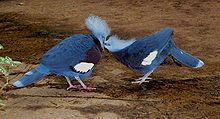

The nests are usually quite small platforms made of branches, but more rarely they are brooded in finished caves in trees, rocks or in the ground. Some Australian species breed frequently on the ground. In the case of nest-building species, the female is mainly responsible for building; the male, however, hands over the twigs and twigs used to build them. The clutches only contain one or two elliptical, single-colored eggs. In most species the eggs are pure white; cream-colored or pale yellow-brown eggs are only found in some breeding species close to the ground. The boys are Nesthocker , they are naked or in slip roughly furry bedaunt. In the first days of life, they are fed exclusively with crop milk, which they receive by sticking their beak into the mouths of the adult birds.
Endangered pigeon species
The species of pigeon that are particularly endangered include many that are endemic to small island territories . Changes in their habitat due to human intervention and the introduction of competing species or species that are predators of the pigeons contribute to the decline in populations. Pink , Socorro , Grenada and Cuba earth pigeons are examples of island species in which, in addition to the fragmentation of their habitat through clearing and conversion into agricultural land, introduced predators such as feral domestic cats , rats , possums and mongooses have contributed to the decline in populations. In the Tahitian fruit pigeon , a major cause of the population decline that has led to the likely extinction on Moorea and Tahiti has been the settlement of marsh harriers . The remains of this species on Makatea Island are threatened by a resumption of mining there. In the case of the Mindoro and Negros dagger-pigeon as well as the Marquesa pigeon, hunting is seen as a major factor in the decline in populations in addition to the loss of habitat. Geoffroy's pigeon , on the other hand, which is very threatened, occurs on the South American continent. This species is a food specialist that mainly lives on the seeds of two types of bamboo. Extensive deforestation has fragmented the habitat of this species to such an extent that the IUCN considers it possible that this species can no longer be saved from extinction.
One of the essential protective measures is placing important habitats under protection. For some species, human-owned breeding plays an essential role in species conservation. So the Socorrotaube has been wiped out in its homeland. Worldwide, however, there are still around 300 individuals that are bred with the aim of resettling them on Socorro , if the conditions are created there that make such a resettlement promising. The procedure was similar for the pink pigeon native to Mauritius , which has been successfully reintroduced for years.
Systematics
The Columbidae is the only family of the order of the pigeon birds (Columbiformes) with about 42 genera and more than 300 species . The flightless species Dodo and Rodrigues solitaire from the Mascarene Islands, which were eradicated in the 18th century, are also included in this family, according to recent findings. The list of genera given here and the numbers of species follow the IOC World Bird List.

-
Blue fruit pigeons ( Alectroenas ) - 4 species, including 1 †
- Paradise fruit pigeon ( Alectroenas pulcherrima )
- Madagascar fruit pigeon ( Alectroenas madagascariensis )
- Mauritius fruit pigeon ( Alectroenas nitidissima ) †
- Comoros fruit pigeon ( Alectroenas sganzini )

-
Indo-Pacific earth pigeons ( Alopecoenas ) - 18 species (including recently extinct or subfossil species)
- Huahine earth dove ( Alopecoenas sp. ) (Subfossil)
- Rota earth dove ( Alopecoenas sp. ) (Subfossil)
- Western gray breast dove ( Alopecoenas beccarii )
- Gray-forehead pigeon ( Alopecoenas canifrons )
- Polynesian earth dove or Tahitian dove ( Alopecoenas erythroptera )
- Tanna earth dove ( Alopecoenas ferruginea ) †
- Wetar pigeon ( Alopecoenas hoedtii )
- Job pigeon ( Alopecoenas jobiensis )
- Ponape earth dove or Caroline dove ( Alopecoenas kubaryi )
- Henderson's pigeon ( Alopecoenas leonpascoi ) (subfossil)
- New Caledonian Earth Dove ( Alopecoenas longitarsus ) (subfossil)
- Norfolk Earth Dove ( Alopecoenas norfolciensis ) †
- Giant Earth Dove ( Alopecoenas nui ) (subfossil)
- Marquesa pigeon ( Alopecoenas rubescens )
- San Cristobal pigeon ( Alopecoenas salamonis ) †
- Santa Cruz Pigeon ( Alopecoenas sanctaecrucis )
- Purple shoulder pigeon ( Alopecoenas stairi )
- Maiden pigeon ( Alopecoenas xanthonurus )
-
Aplopelia - 1 kind
- Zimttaube ( Aplopelia larvata )
- Collared pigeons ( Caloenas ) - 1 item
- Collar pigeon ( Caloenas nicobarica )
-
Green-winged pigeons ( Chalcophaps ) - 2 species
- Green-winged pigeon ( Chalcophaps indica )
- Brown-backed green-winged pigeon ( Chalcophaps stephani )
-
Claravis - 3 types
- Geoffroy's pigeon ( Claravis geoffroyi )
- Purple breast pigeon ( Claravis mondetoura )
- Blue dove ( Claravis pretiosa )



-
Field pigeons ( Columba ) - 33 species
- White-necked pigeon ( Columba albilinea )
- White-nosed dove ( Columba albinucha )
- Amharic Pigeon ( Columba albitorques )
- Silver pigeon ( Columba argentina )
- Olive pigeon ( Columba arquatrix )
- Bolles Laurel Pigeon ( Columba bollii )
- Bronze pigeon ( Columba delegorguei )
- Nilgiritaube ( Columba elphinstonii )
- Bank pigeon ( Columba eversmanni )
- Guinea pigeon ( Columba guinea )
- Black-billed olive pigeon ( Columba hodgsonii )
- Gloss head pigeon ( Columba iriditorques )
- Violet pigeon ( Columba janthina )
- Laurel pigeon ( Columba junoniae )
- White-breasted pigeon ( Columba leucomela )
- Snow pigeon ( Columba leuconota )
-
Rock dove ( Columba livia )
-
Domestic pigeon and carrier pigeon ( Columba livia f. Domestica )
- City pigeon or street pigeon - feral form of the domestic pigeon
-
Domestic pigeon and carrier pigeon ( Columba livia f. Domestica )
- Malherbetaube ( Columba malherbii )
- Stock dove ( Columba oenas )
- Somali pigeon ( Columba oliviae )
- Yellow-footed pigeon ( Columba pallidiceps )
- Andaman pigeon ( Columba palumboides )
- Wood pigeon ( Columba palumbus )
- Comoros pigeon ( Columba polleni )
- Himalayan pigeon ( Columba pulchricollis )
- Copper pigeon ( Columba punicea )
- Cliff pigeon ( Columba rupestris )
- Red-billed olive pigeon ( Columba sjostedti )
- Long-tailed olive pigeon ( Columba thomensis )
- Ceylon pigeon ( Columba torringtoni )
- Silver- necked pigeon ( Columba trocaz )
- Congo pigeon ( Columba unicincta )
- White-cheeked pigeon ( Columba vitiensis )

-
Columbina - 7 species
- Buckley pigeon ( Columbina buckleyi )
- Peruvian pigeon ( Columbina cruziana )
- Blue-eyed dove ( Columbina cyanopis )
- Sparrow dust ( Columbina passerina )
- Picue pigeon ( Columbina picui )
- Dwarf dove ( Columbina minuta )
- Rust pigeon ( Columbina talpacoti )
- Spotted belly fruit pigeons ( Cryptophaps ) - 1 item
- Speckled fruit pigeon ( Cryptophaps poecilorrhoa )
- Toothed pigeons ( Didunculus ) - 1
item
- Tooth Taube ( Didunculus strigirostris )
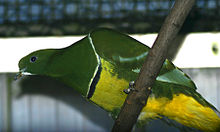
- Split-winged pigeons ( Drepanoptila ) - 1 item
- Split-winged pigeon ( Drepanoptila holosericea )

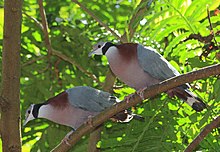
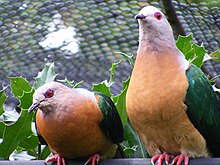
-
Large fruit pigeons ( Ducula ) - 39 species
- Bronze fruit pigeon ( Ducula aenea )
- Tahitian fruit pigeon ( Ducula aurorae )
- Mountain pigeon ( Ducula badia )
- Baker fruit pigeon ( Ducula bakeri )
- Halmahera fruit pigeon ( Ducula basilica )
- Brown-bellied fruit pigeon ( Ducula brenchleyi )
- Two-colored fruit pigeon ( Ducula bicolor )
- Spotted fruit pigeon ( Ducula carola )
- Red-bellied mountain pigeon ( Ducula chalconota )
- Timor fruit pigeon ( Ducula cineracea )
- Moluccan bronze pigeon ( Ducula concinna )
- Marquesas fruit pigeon ( Ducula galeata )
- Finsch fruit pigeon ( Ducula finschii )
- Great Celebes fruit pigeon ( Ducula forsteni )
- Giant fruit pigeon ( Ducula goliath )
- Ducula harrisoni †
- Black- backed fruit pigeon ( Ducula lacernulata )
- Peales fruit pigeon ( Ducula latrans )
- Magpie dove ( Ducula luctuosa )
- Black fruit pigeon ( Ducula melanochroa )
- Great Mindoro Fruit Pigeon ( Ducula mindorensis )
- Black-collar fruit pigeon ( Ducula mullerii )
- Black-headed fruit pigeon ( Ducula myristicivora )
- Caroline fruit pigeon ( Ducula oceanica )
- Tonga pigeon ( Ducula pacifica )
- White-eyed fruit pigeon ( Ducula perspicillata )
- Gray island pigeon ( Ducula pickeringii )
- Black -eye fruit pigeon ( Ducula pinon )
- Gray fruit pigeon ( Ducula pistrinaria )
- Gray-headed fruit pigeon ( Ducula poliocephala )
- Celebes bindtail fruit pigeon ( Ducula radiata )
- Pink-headed fruit pigeon ( Ducula rosacea )
- Red wart fruit pigeon ( Ducula rubricera )
- Red-tailed fruit pigeon ( Ducula rufigaster )
- Spot Fruchttaube ( Ducula spilorrhoa )
- Yellow imperial pigeon ( Ducula subflavescens )
- Dark fruit pigeon ( Ducula whartoni )
- Banded fruit pigeon ( Ducula zoeae )
- Wandering pigeons ( Ectopistes ) - 1 item
- Passenger pigeon ( Ectopistes migratorius ) †

-
Dagger-pigeons ( Gallicolumba ) - 7 species
- Bartlett's dagger-sting dove ( Gallicolumba crinigera )
- Negros dagger-stinging pigeon ( Gallicolumba keayi )
- Luzon dagger-stinging pigeon ( Gallicolumba luzonica )
- Tawitawi pigeon ( Gallicolumba menagei ) (extremely rare or probably extinct)
- Plateau dove ( Gallicolumba platenae )
- Golden breast dove ( Gallicolumba rufigula )
- Hop pigeon ( Gallicolumba tristigmata )

-
Indo-Australian pigeons ( Geopelia ) - 5 species
- Diamond dove ( Geopelia cuneata )
- Copper-necked pigeon ( Geopelia humeralis )
- Timor pigeon ( Geopelia maugeus )
- Peace dove ( Geopelia placida )
- Hawk pigeon ( Geopelia striata )
-
Geophaps - 3 species
- Redhead pigeon ( Geophaps plumifera )
- Letter dove ( Geophaps scripta )
- Shed breast Taube ( geophaps smithii )
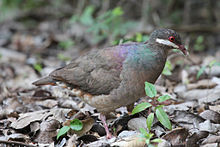
-
American earth pigeons ( Geotrygon ) - 9 species
- Gundlachtaube ( Geotrygon caniceps )
- Gloss earth dove ( Geotrygon chrysia )
- White-fronted Gundlachtaube ( Geotrygon leucometopia )
- Red earth dove ( Geotrygon montana )
- Mustache pigeon ( Geotrygon mystacea )
- Purple sapphire dove ( Geotrygon purpurata )
- Sapphire Taube ( Geotrygon saphirina )
- Jamaican earth dove ( Geotrygon versicolor )
- Violet earth dove ( Geotrygon violacea )
-
Crowned pigeons ( Goura ) - 4 species
- Crowned pigeon ( Goura cristata )
- Red breasted crowned pigeon ( Goura scheepmakeri )
- Sclater's red-breasted crowned pigeon ( Goura sclaterii )
- Fan pigeon ( Goura victoria )
-
Mountain pigeons ( Gymnophaps ) - 3 species
- Albertistaube ( Gymnophaps albertisii )
- Long-tailed mountain pigeon ( Gymnophaps mada )
- Pale mountain pigeon ( Gymnophaps solomonensis )
- Maori fruit pigeons ( Hemiphaga ) - 1
item
- Maori fruit pigeon ( Hemiphaga novaeseelandiae )
-
Henicophaps - 2 types
- White-headed pigeon ( Henicophaps albifrons )
- Red-headed pigeon ( Henicophaps foersteri )
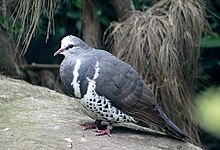
- Wong pigeons ( Leucosarcia ) - 1 type
- Wonga Pigeon ( Leucosarcia melanoleuca )

-
Sonic rocking pigeons ( Leptotila ) - 11 species
- Brown-backed pigeon ( Leptotila battyi )
- Gray-breasted pigeon ( Leptotila cassinii )
- Tolima dove ( Leptotila conoveri )
- Jamaican pigeon ( Leptotila jamaicensis )
- White-faced dove ( Leptotila megalura )
- Yellow-bellied pigeon ( Leptotila ochraceiventris )
- Pigeon ( Leptotila pallida )
- Gray-headed pigeon ( Leptotila plumbeiceps )
- Red ax pigeon ( Leptotila rufaxilla )
- White-forehead dove ( Leptotila verreauxi )
- Grenada dove ( Leptotila wellsi )
-
Leptotrygon - 1 type
- Veragua quail pigeon ( Leptotrygon veraguensis )
- Hooded fruit pigeons ( Lopholaimus ) - 1
item
- Crested pigeon ( Lopholaimus antarcticus )

-
Cuckoo doves ( Macropygia ) - 9 species
- Pink-breasted Cuckoo Dove ( Macropygia amboinensis )
- Indonesia cuckoo pigeon ( Macropygia emiliana )
- Fox- red cuckoo pigeon ( Macropygia mackinlayi )
- Great cuckoo pigeon ( Macropygia magna )
- Little Cuckoo Dove ( Macropygia nigrirostris )
- Dark cuckoo pigeon ( Macropygia phasianella )
- Little Cuckoo Dove ( Macropygia ruficeps )
- Andaman cuckoo pigeon ( Macropygia rufipennis )
- Philippines cuckoo pigeon ( Macropygia tenuirostris )
- Malayan cuckoo pigeon ( Macropygia unchall )

-
Metriopelia - 4 species
- Aymara pigeon ( Metriopelia aymara )
- Spectacled doves ( Metriopelia ceciliae )
- Cordilleras ( Metriopelia melanoptera )
- Moreno dove ( Metriopelia morenoi )
-
Microgoura - 1 type
- Solomon pigeon ( Microgoura meeki ) †
-
Nesoenas - 3 species, including 1 †
- Rose pigeon ( Nesoenas mayeri )
- Madagascar turtle dove ( Nesoenas picturata )
- Nesoenas rodericana †

- Pointed pigeons ( Ocyphaps ) - 1 kind
- Crested pigeon ( Ocyphaps lophotes )
- Cape pigeon ( Oena ) - 1
item
- Cape pigeon ( Oena capensis )
- Pheasant pigeons ( Otidiphaps ) - 1 kind
- Pheasant pigeon ( Otidiphaps nobilis )


-
American field pigeons ( Patagioenas ) - 17 species
- Araucanian pigeon ( Patagioenas araucana )
- Caribbean pigeon ( Patagioenas caribaea )
- Red-backed pigeon ( Patagioenas cayennensis )
- Naked- eye pigeon (American pigeon) ( Patagioenas corensis )
- Scaled- neck pigeon ( Patagioenas fasciata )
- Red-billed pigeon ( Patagioenas flavirostris )
- Goodson pigeon ( Patagioenas goodsoni )
- Rose shoulder pigeon ( Patagioenas inornata )
- White-headed pigeon ( Patagioenas leucocephala )
- Spotted pigeon ( Patagioenas maculosa )
- Short-billed pigeon ( Patagioenas nigrirostris )
- Salvin Pigeon ( Patagioenas oenops )
- Picazuro pigeon ( Patagioenas picazuro )
- Wine pigeon ( Patagioenas plumbea )
- Shed abdominal Taube ( Patagioenas speciosa )
- Antilles pigeon ( Patagioenas squamosa )
- Purple pigeon ( Patagioenas subvinacea )
-
Australian ground pigeons ( Petrophassa ) - 2 species
- White-mirrored pigeon ( Petrophassa albipennis )
- Red mirror pigeon ( Petrophassa rufipennis )
-
Pezophaps - 1
item
- Rodrigues solitaire ( Pezophaps solitaria ) †
-
Brown fruit pigeons ( Phapitreron ) - 8 species
- Amethyst dove ( Phapitreron amethystina )
- Short-billed ear-pigeon ( Phapitreron brevirostris )
- Brown-headed pigeon ( Phapitreron brunneiceps )
- Dark- eared pigeon or gray-headed pigeon ( Phapitreron cinereiceps )
- Cebute dove ( Phapitreron frontalis )
- Philippines black- streaked pigeon or ear-pigeon ( Phapitreron leucotis )
- Western visaya pigeon ( Phapitreron maculipectus )
- Cinnamon pigeon ( Phapitreron nigrorum )
-
Bronze winged doves ( Phaps ) - 3 species
- Bronze-winged pigeon ( Phaps chalcoptera )
- Bush pigeon ( Phaps elegans )
- Harlequin Pigeon ( Phaps histrionica )



-
Downy pigeons ( Ptilinopus ) - 50 species
- Gray-bellied fruit pigeon ( Ptilinopus alligator )
- Negros fruit pigeon ( Ptilinopus arcanus ) (probably extinct)
- Yellow-fronted fruit dove ( Ptilinopus aurantiifrons )
- Scarlet Breast Pigeon ( Ptilinopus bernsteinii )
- Makatea pigeon ( Ptilinopus chalcurus )
- Bald pigeon ( Ptilinopus cinctus )
- Tuamotu pigeon ( Ptilinopus coralensis )
- Purple cap fruit pigeon ( Ptilinopus coronulatus )
- Red-naped Downy Pigeon ( Ptilinopus dohertyi )
- White-capped fruit pigeon ( Ptilinopus dupetithouarsii )
- Whitehead pigeon ( Ptilinopus eugeniae )
- Fishing pigeon ( Ptilinopus fischeri )
- Caruncle fruit dove or warty fruit dove ( Ptilinopus granulifrons )
- Red-bellied fruit pigeon ( Ptilinopus greyii )
- Long-billed fruit pigeon ( Ptilinopus huttoni )
- Blue-headed fruit pigeon ( Ptilinopus hyogaster )
- Button downy pigeon ( Ptilinopus insolitus )
- Henderson fruit pigeon ( Ptilinopus insularis )
- Orange-bellied fruit pigeon ( Ptilinopus iozonus )
- Jambu dove ( Ptilinopus jambu )
- Yellow-headed fruit pigeon ( Ptilinopus layardi )
- Black-throated fruit pigeon ( Ptilinopus leclancheri )
- Yellow Fijian Downy Pigeon ( Ptilinopus luteovirens )
- Long-tailed fruit pigeon ( Ptilinopus magnificus )
- Bloodwing fruit dove ( Ptilinopus marchei )
- Black-necked fruit pigeon ( Ptilinopus melanospilus )
- Red beard pigeon ( Ptilinopus mercierii ) (probably extinct)
- Merrill fruit pigeon ( Ptilinopus merrilli )
- Blue-capped fruit pigeon ( Ptilinopus monacha )
- Dwarf pigeon ( Ptilinopus nanus )
- Yellow-breasted pigeon ( Ptilinopus occipitalis )
- Ornate pigeon ( Ptilinopus ornatus )
- Palau fruit pigeon ( Ptilinopus pelewensis )
- Pink-spotted fruit pigeon ( Ptilinopus perlatus )
- Yellow pecker pigeon ( Ptilinopus perousii )
- Red-crowned fruit pigeon ( Ptilinopus porphyraceus )
- Red-necked Downy Pigeon ( Ptilinopus porphyreus )
- Beautiful Downy Pigeon ( Ptilinopus pulchellus )
- Purple-capped fruit pigeon ( Ptilinopus purpuratus )
- Rarotonga fruit pigeon ( Ptilinopus rarotongensis )
- Pink-capped fruit pigeon ( Ptilinopus regina )
- Solomon Islands fruit pigeon ( Ptilinopus richardsii )
- Coral downy pigeon ( Ptilinopus rivoli )
- Mariana fruit pigeon ( Ptilinopus roseicapilla )
- Yellow-bellied fruit pigeon ( Ptilinopus solomonensis )
- Dark-chin fruit pigeon ( Ptilinopus subgularis )
- Royal fruit dove ( Ptilinopus superbus )
- Silver spot pigeon ( Ptilinopus tannensis )
- Rotlatz fruit pigeon ( Ptilinopus viridis )
- Fijian red downy pigeon ( Ptilinopus victor )
- Golden shoulder fruit pigeon ( Ptilinopus wallacii )
-
Raphus - 1
item
- Dodo ( Raphus cucculatus ) †

-
Long-tailed pigeons ( Reinwardtoena ) - 3 species
- Black Reinwardttaube ( Reinwardtoena browni )
- Solomon pigeon ( Reinwardtoena crassirostris )
- Red-brown Reinwardttaube ( Reinwardtoena reinwardtii )
-
Scardafella - 2 types
- Inca pigeon ( Scardafella inca )
- Pangolin ( Scardafella squammata )
-
Spilopelia - 2 species
- Pearl-necked pigeon ( Spilopelia chinensis )
- Palm pigeon ( Spilopelia senegalensis )
- Cuban pigeons ( Starnoenas ) - 1 type
- Cuban pigeon ( Starnoenas cyanocephala )
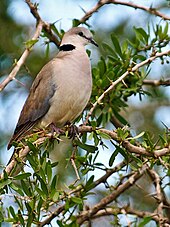
-
Lovebirds ( Streptopelia ) - 13 species
- Giggle dove ( Streptopelia bitorquata )
- Cape pigeon ( Streptopelia capicola )
- Collared dove ( Streptopelia decaocto )
- Brillentaube ( Streptopelia decipiens )
- Adamaua turtledove ( Streptopelia hypopyrrha )
- Black turtle dove ( Streptopelia lugens )
- Oriental turtle dove ( Streptopelia orientalis )
- Reichenowtaube ( Streptopeliareichenowi )
- North African laughing pigeon ( Streptopelia roseogrisea )
- Crescent dove ( Streptopelia semitorquata )
- Wine-red neck-ring pigeon ( Streptopelia tranquebarica )
- Turtle dove ( Streptopelia turtur )
- Red pigeon ( Streptopelia vinacea )



-
Green doves ( Treron ) - 17 species
- Gray-fronted pompadour pigeon ( Treron affinis )
- Pointed-tailed green pigeon ( Treron apicauda )
- Moluccan pompadour pigeon ( Treron aromaticus )
- Madagascar green pigeon ( Treron australis )
- Philippines pompadour pigeon ( Treron axillaris )
- Bind Grüntaube ( Treron bicincta )
- Bare-faced green pigeon ( Treron calva )
- Great green pigeon ( Treron capellei )
- Andaman pompadour pigeon ( Treron chloropterus )
- Thick-billed green pigeon ( Treron curvirostra )
- Gray -breasted green pigeon ( Treron delalandii )
- Flores green pigeon ( Treron floris )
- Formosa green pigeon ( Treron formosae )
- Cinnamon-head green pigeon ( Treron fulvicollis )
- Gray-masked green pigeon ( Treron griseicauda )
- Comoros green pigeon ( Treron griveaudi )
- Little green pigeon ( Treron olax )
- Yellow-bellied green pigeon ( Treron oxyurus )
- Riukiu green pigeon ( Treron permagnus )
- Ash-head pompadour dove ( Treron phayrei )
- Red-shouldered green pigeon ( Treron phoenicoptera )
- Pemba green pigeon ( Treron pombaensis )
- Andaman green pigeon ( Treron pompadora )
- Green Timor Pigeon ( Treron psittacea )
- Sao Thomé green pigeon ( Treron sanctithomae )
- White-bellied green pigeon ( Treron seimundi )
- Siebold's green pigeon ( Treron Sieboldii )
- Wedge-tailed green pigeon ( Treron sphenurus )
- Sumba green pigeon ( Treron teysmannii )
- Spring pigeon ( Treron vernans )
- Bruce's green pigeon ( Treron waalia )
- Thick-billed earth pigeons ( Trugon ) - 1 item
- Earth dove ( Trugon terrestris )

-
White-faced pigeons ( Turacoena ) - 2 species
- Manadotaube ( Turacoena manadensis )
- Timor pigeon ( Turacoena modesta )
-
African bush pigeons ( Turtur ) - 5 species
- Ore pigeon ( Turtur abyssinicus )
- Steel spot pigeon ( Turtur afer )
- Maiden dove ( Turtur brehmeri )
- Bronze spot dove ( Turtur chalcospilos )
- Tambourine pigeon ( Turtur tympanistria )
- Campo dust ( uropelia ) - 1
item
- Campo dust ( Uropelia campestris )

-
Mourning doves ( Zenaida ) - 7 species
- Lattice dove ( Zenaida auriculata )
- Coastal pigeon ( Zenaida aurita )
- White-winged pigeon ( Zenaida asiatica )
- Galapagos pigeon ( Zenaida galapagoensis )
- Socorrotaube ( Zenaida graysoni )
- Carolina pigeon ( Zenaida macroura )
- Perute dove ( Zenaida meloda )
-
Quail pigeons ( Zentrygon ) - 8 species
- Scattered pigeon ( Zentrygon albifacies )
- Tuxtla quail pigeon ( Zentrygon carrikeri )
- Chiriqui quail pigeon ( Zentrygon chiriquensis )
- Costa Rican quail pigeon ( Zentrygon costaricensis )
- Peruvian quail pigeon ( Zentrygon frenata )
- Goldman quail pigeon ( Zentrygon goldmani )
- Purple- backed quail pigeon ( Zentrygon lawrencii )
- White-faced quail pigeon ( Zentrygon linearis )
symbolism
Because ancient science assumed that the dove has no gall bladder and is therefore free from all bitter and evil, they are considered a symbol of peace ( dove of peace ) , also of innocence, love (see turtledove ), loyalty (see wedding dove , release dove ) and motherhood, the soul and Christian interpreted the Holy Spirit as well as on coats of arms . The symbolism can be found in numerous cultures. In the context of mourning or the burial of a deceased, the white dove stands above all for the freedom that a soul receives after death and after leaving the human body.
history
swell
- Antiquity - late antiquity: Dioscurides 1st century --- Pliny 1st century --- Galen 2nd century --- Liber medicinae ex animalibus 7th century
- Arab Middle Ages: Avicenna 11th century
- Latin Middle Ages: Hildegard von Bingen 12th century --- Konrad von Megenberg 14th century --- Herbarius Moguntinus 1484 --- Gart der Gesundheit 1485 --- Hortus sanitatis 1491
Historical illustrations
Liber medicinae ex animalibus 7th century
..... Abdul ibn Butlan ..... ..... 14th century
..... Abdul ibn Butlan ..... ..... 14th century
Hortus sanitatis 1491
literature
- Bruce M. Beehler , Thane K. Pratt: Birds of New Guinea; Distribution, Taxonomy, and Systematics. Princeton University Press, Princeton 2016, ISBN 978-0-691-16424-3 .
- Urs N. Glutz v. Blotzheim and Kurt M. Bauer: Handbook of the birds of Central Europe. Vol. 9th, 2nd edition, AULA-Verlag, Wiesbaden 1994, pp. 9-11. ISBN 3-89104-562-X .
- David Gibbs, Eustace Barnes and John Cox: Pigeons and Doves - A Guide to the Pigeons and Doves of the World. Pica Press, Sussex 2001, ISBN 90-74345-26-3 .
- Alois Münst, Josef Wolters: Pigeons - The types of wild pigeons. 2nd expanded and revised edition, Verlag Karin Wolters, Bottrop 1999, ISBN 3-9801504-9-6 .
- Gerhard Rösler: The wild pigeons of the earth - free living, keeping and breeding. M. & H. Schaper Verlag, Alfeld-Hannover 1996, ISBN 3-7944-0184-0 .
Web links
Individual evidence
- ↑ Tauberich | Spelling, meaning, definition, origin. Retrieved July 23, 2020 .
- ↑ pigeon | Spelling, meaning, definition, origin. In: Duden. Retrieved July 22, 2018 .
- ↑ Tauber | Spelling, meaning, definition, origin. In: Duden. Retrieved July 22, 2018 .
- ↑ Duden | Cocks | Spelling, meaning, definition, origin. Retrieved December 19, 2019 .
- ↑ Duden | Hen | Spelling, meaning, definition, origin. Retrieved December 20, 2019 .
- ^ Beehler & Pratt: Birds of New Guinea , p. 63.
- ↑ Rösler, p. 19
- ^ Gibbs, p. 213
- ↑ Rösler, p. 25
- ↑ Rösler, p. 318
- ↑ C. Blanvillain et al. a .: Impact of introduced birds on the recovery of the Tahiti Flycatcher ( Pomarea nigra ), a critically endangered forest bird of Tahiti. In: Biological Conservation 109, No. 2, February 2003. pp. 197-205.
- ↑ Neil Hetherington: Species Profile: Australasian Harrier ( Memento of the original from May 26, 2009 in the Internet Archive ) Info: The archive link was automatically inserted and not yet checked. Please check the original and archive link according to the instructions and then remove this notice. www.canterburynature.org. September 2006. Accessed December 3, 2016.
- ↑ Rösler, p. 21.
- ↑ BirdLife Factsheet accessed June 16, 2009
- ↑ Rösler, p. 23
- ^ Columbidae on the IOC World Bird List, Version 6.4. accessed November 27, 2016
- ↑ a b Banks, Weckstein, Remsen & Johnson: Classification of a clade of New World doves (Columbidae: Zenaidini) . Zootaxa 3669 (2): 184-188 doi: 10.11646 / zootaxa.3669.2.11
- ^ A b Charles Victor Daremberg and Friedrich Anton Reuss (1810–1868). S. Hildegardis Abbatissae Subtilitatum Diversarum Naturarum Creaturarum Libri Novem. Physica , Book VI (De avibus), Chapter 30: Columba . Chapter 31: Turtur . Migne, Paris 1855. Col. 1299 (digitized) . Translation: Marie-Louise-Portmann, Basel 1991: From the dove. The pigeon is more cold than warm and loves the morning of the day, that is, its first beginning, which is moderately cold, more than the warmth. And it is simple-minded and timid, and therefore it flies in a flock, so that it is less harmed by other birds. And because she is cold, she is easily hungry. And the food in it does not get as warm as in other birds, and therefore it is quickly hungry and it eats more than another bird of its size. And its flesh is not firm, but rather dry, and it does not give a person much juice, and it does not serve a healthy person much for food, even if it does not harm him. It harms the sick person who is weak in the body when he has eaten it. But the wood pigeon and the wood pigeon also have the same nature, except that they are in the woods, and therefore they are a bit bitter and larger, and that they eat the forage of the woods. But neither these nor those are useful as remedies. --- From the turtledove. The turtledove is warm and dry, and of manly strength, and it is not timid, and it always has a servant, so to speak. And because it does not have moisture and does not change its way of life in different (directions), bile cannot grow in it, as is the case in humans. In those who have good will, the bile cannot grow, but it decreases in them. And when he has a criminal mind, the bile increases in him. And the meat of the turtledove is unsuitable for eating because it causes gout in humans. The rest is no good.
- ^ Margret Nussbaum: dove, fire, wind. In: Katholisch.de. May 14, 2016, accessed June 4, 2020 (German).
- ↑ Pedanios Dioscurides . 1st century: De Medicinali Materia libri quinque. Translation. Julius Berendes . Pedanius Dioscurides' medicine theory in 5 books. Enke, Stuttgart 1902, pp. 191–192 (Book II, Chapter 97): blood from pigeons (digital copy) ; (Book II, Chapter 98): Pigeon droppings (digitized version)
- ↑ Pliny the Elder , 1st century: Naturalis historia book X, chapters 52–53 (§ 104–110): Palumbes (digitized version ) ; Translation Külb 1855 (digitized version )
- ↑ Galen , 2nd century, De simplicium medicamentorum temperamentis ac facultatibus , Book X, Chapter II / 3 (based on the edition Kühn 1826, Volume XII, p. 256): De sanguine columbae (digital copy ) Book X, Chapter II / 25 (based on the Kühn 1826 edition, Volume XII, p. 302): De stercare columbino (digitized version )
- ↑ Pressure: Sexti Placiti Papyriensis, de medicamentis ex animalibus, libellus. Chapter 30: De columba Johann Petri, Nuremberg 1538. (digitized version )
- ↑ Avicenna , 11th century: Canon of Medicine . Translation and adaptation by Gerhard von Cremona , Arnaldus de Villanova and Andrea Alpago (1450–1521). Basel 1556, Volume II, Chapter 132: Columba (digitized version)
- ^ Konrad von Megenberg , 14th century: Book of nature. Output. Franz Pfeiffer . Aue, Stuttgart 1861, p. 179 (IIIb / 22): Pigeons (digitized)
- ↑ Herbarius Moguntinus , Mainz 1484, Part II, Chapter 81: Columba (digitized version)
- ↑ Gart der Gesundheit . Mainz 1485, Chapter 144: Columba (digitized version)
- ↑ Hortus sanitatis 1491, Mainz 1491, Part III (De avibus), Chapter 32: Columba (digitized version)
- ↑ Pressure: Sexti Placiti Papyriensis, de medicamentis ex animalibus, libellus. Johann Petri, Nuremberg 1538. (digitized version )
- ↑ Puli Columbini . In: Abdul ibn Butlan : Tacuinum sanitatis in medicina. 14th century, Codex Vindobon. Ser. Nova 2644, sheet 26v. Transcription and translation of the text by Franz Unterkircher: Tacuinum sanitatis ... Graz 2004, p. 104: Puli columbini. Columhini sweater: complexio calida et humida. Electio: acquirentes iam sibi cibum. iuvamentum: conferunt paralixi ex frigiditate. nocumentum: nocent cerebro et uigilijs, maxime assati. Remotio nocumenti: cum aceto et coriandro. Quid generant: sanguinem calidum fortis caliditatis. conveniunt magis frigidis, decrepitis et humidis, hyeme et regionibus niuosis. --- Young pigeons. Young pigeons: warm and moist complexion. It is preferable to those who are already looking for their own food. Benefit: good against strokes caused by cold. Harm: they harm the brain and cause insomnia, especially when fried. Preventing the harm: with vinegar and coriander. What they produce: warm blood of intense heat. Particularly beneficial for people with a cold complexion, the weak and those with a damp complexion, in winter and in snowy areas.
- ↑ Turtures . In: Abdul ibn Butlan : Tacuinum sanitatis in medicina. 14th century, Codex Vindobon. Ser. Nova 2644, sheet 26v. Transcription and translation of the text by Franz Unterkircher: Tacuinum sanitatis ... Graz 2004, p. 106: Turtures. Turtures: complexio calida et humida in 2 °, minoris tamen humiditatis quam pulli columbini. Electio: iuvenes, cum volare incipere debent. iuvamentum: egritudinibus nervorum frixe et assate. cum cera intromissa conferunt fluxui ventris. Nocumentum: sunt famosi nutrimenti, non tantum tamen ut columbi. Remotio nocumenti: cum aceto et coriandro. Quid generant: sanguinem calidum et acutum. conveniunt magis frigidis humidis, decrepitis, hyeme et niuosis regionibus. --- lovebirds. Lovebirds: Complexion: warm and humid in the 2nd degree, but less moisture than young pigeons. Preferable: young people who are just beginning to fly. Benefit: if they are roasted and fried, against nervous diseases, with the addition of wax they are good against the flow of the abdomen. Damage: they have known good nutrients, but not as much as the pigeons. Preventing the harm: with vinegar and coriander. What they produce: warm and sharp blood. Particularly beneficial for people with cold and damp complexion, for the weak, in winter and in snowy areas.








